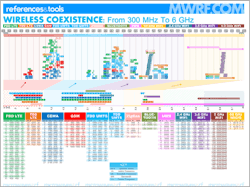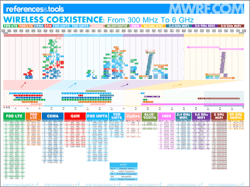Wireless Coexistence (.PDF Download)
Wireless Coexistence: From 300 MHz To 6 GHz
By: Jean-Jacques DeLisle
[Register or Login at the bottom of this page to gain access to this download] In a highly competitive technology world with a limited spectrum, many wireless standards are forced to struggle over the few megahertz of bandwidth allowed to them.This struggle is intensified as these various standards are often occupying the same spectrum. There are stiff regulations for non-interference and transmit power by agencies like the Federal Communications Commission (FCC) in the USA. This has led to creative solutions for balancing power, frequency hopping, spread spectrum techniques, time/frequency division multiplexing, and many others.
To get an idea of just a few of the competing wireless standards, the reference “Wireless Coexistence” displays many of the common standards that are used today, and a few that we may see in the near future. In the reference, a color-coded chart provides a spatially accurate frequency mapping of the different operator bands of these common standards. A straight-edge can be used to see what different operator bands overlap. A rough and fine detail frequency mapping is provided along with tables for each of the operator bands’ band number, uplink/downlink frequency, and bandwidth. All the frequencies represented in the tables are the center frequencies of the operator bands.

